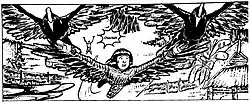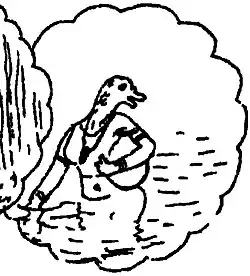Ucheks (Meitei for 'Birds') have significant roles in different elements of Meitei culture, including but not limited to Meitei cuisine, Meitei dances, Meitei festivals, Meitei folklore, Meitei folktales, Meitei literature, Meitei mythology, etc.
Crows in Meitei culture
Doves and pigeons in Meitei culture
Goddess of doves and pigeons

In Meitei mythology and religion, Khunu Leima (Meitei: ꯈꯨꯅꯨ ꯂꯩꯃ, romanized: /khoo-noo lei-ma/), also known as Khunureima (Meitei: ꯈꯨꯅꯨꯔꯩꯃ, romanized: /khoo-noo-rei-ma/), is a goddess associated with pigeons and doves. She is one of the three dearest daughters of the sky god. Along with her two sisters, Nganu Leima and Shapi Leima, she got married the same person, who is a mortal.[1]
Pigeon in the story of Sandrembi and Chaisra
In the Meitei folktale of Sandrembi and Chaisra, Lady Sandrembi, after being killed by her stepsister and stepmother, transformed herself into a pigeon and flew into the Royal Garden of the king, her husband. She perched on a tree branch and told the Royal Gardener, about the forgetfulness of the King about his wife Queen Sandrembi, the animal epidemic happened in the kingdom, the grievances of the Prince (Sandrembi's son) and the loss of the gardener's own sickle in a recent past. Sandrembi told him to report these words to the King. The king, on hearing the news, came by himself, to the pigeon in the garden. Holding some grains of paddy in his hands, the King brought and kept the supernatural bird (Sandrembi's bird form) in his custody. Even as a pigeon, she took care of the Prince. During the King's absence, Chaisra (the imposter and Sandrembi's stepsister) slaughtered the pigeon and cooked a nice meal from the meat.[2] Upon knowing that the food was made of the very pigeon, the king refused to dine it and buried the pigeon's remains in the ground behind the Royal Kitchen.[2]
Hornbill in Meitei culture

The Meitei folktale of Uchek Langmeitong (Uchek Langmeidong), also known as Chekla Langmeitong (Chekla Langmeidong), of Ancient Kangleipak (early Manipur),[3][4] narrates the tragic story of a mortal girl named "Hayainu" (alias Nongdam Atombi), who turned herself into a Langmeitong (Meitei for 'hornbill bird') as she was unable to suffer the ill treatments of her cruel and selfish stepmother, in her father's absence.[5][3][4][6]
Parrots in Meitei culture

Sanagi Tenawa : Golden parrot
In a Meitei folktale of a Sanagi Tenawa (Meitei for 'golden parrot'), a divine golden parrot used to live in a land of rocks. It possessed magical spells, due to which it made all the trees of the land able to talk and move like animals. The parrot was famous far and wide. In a far away kingdom, a courageous and clever prince got the news of the parrot, which he wanted to be brought to his kingdom. Henceforth, in the dead of the night, the prince and his friend, who was a minister's son, proceeded to find the parrot, without informing his father, the king. For three full moons of phase, they travelled until they finally reached the land of rocks. Surprised to see the rocks and the talking trees, and wandering around, they found out a door way to go inside a cave. When the prince was about to go inside the cave, he heard a loud sound. The voice from unknown source asked him to stop going inside the cave for the parrot. Upon investigated, they found the voice was from a tree monster at the door.[7]
The monster warned them of asking them three questions before they enter. If answered incorrectly, they would turn into stones. The first question was 'Who is the happiest man alive?' The prince's answer was 'One who owes no debt to anyone and who is healthy and free from any illness.' The second question was 'What are the main qualities of a king?' The prince's answer was 'A king should conduct according to the wishes of the people, should take care of the poor and destitute, and should treat everyone equally.' The final question was 'Name the gods one can see one's own eyes?' The final answer was 'One's birth parents are one's gods that they can see with their eyes.'[7]
The tree monster was satisfied with all the correct answers and it praised the prince for his wisdom and intelligence. It allowed the prince for entry and was vanished from the spot as it was waiting for someone who could answer all the questions correctly before he leave. Inside the cave, the golden parrot was found sitting on a golden plate, as was once being under captivity of the tree monster. The prince was told by the parrot about the way to change the stones into princes. He had to sprinkle water of the golden pond on them. The prince did and undo the spells/curses of the stones, bringing them back to life. The princes thanked the prince and went back to their respective kingdoms. Finally, the parrot was brought by the prince and his friend to their kingdom.[7]
Waterfowls in Meitei culture

In Meitei mythology and religion, Nganu Leima (Meitei: ꯉꯥꯅꯨ ꯂꯩꯃ, romanized: /ngaa-noo lei-ma/), also known as Nganureima (Meitei: ꯉꯥꯅꯨꯔꯩꯃ, romanized: /ngaa-noo-rei-ma/), is a goddess associated with ducks and other water birds . She is one of the three dearest daughters of the sky god. Along with her two sisters, Khunu Leima and Shapi Leima, she married to the same person.[8]
See also
Notes
References
- ↑ –Singh, Moirangthem Kirti (1993). Folk Culture of Manipur. Manas Publications. ISBN 978-81-7049-063-0.
–Manipuri Phungawari (in Manipuri). 2014. p. 202.
–Eben Mayogee Leipareng (in Manipuri). 1995. p. 107.
–Tal Taret (in Manipuri). 2006. p. 43.
–Regunathan, Sudhamahi (2005). Folk Tales of the North-East. Children's Book Trust. ISBN 978-81-7011-967-8. - 1 2 "Sandrembi and Chaisra". e-pao.net.
- 1 2 Handoo, Jawaharlal; Siikala, Anna-Leena (1999). Folklore and Discourse. Zooni Publications. ISBN 978-81-7342-054-2.
- 1 2 Enact. Pauls Press. 1978.
- ↑ Singh, Moirangthem Kirti (1993). Folk Culture of Manipur. Manas Publications. ISBN 978-81-7049-063-0.
- ↑ –"Human turning into Uchek Langmei Meena Uchek Langmei Onba". e-pao.net.
–Ahuja, Chaman (2012). Contemporary Theatre of India: An Overview. National Book Trust, India. ISBN 978-81-237-6492-4. - 1 2 3 "Sanagi Tenawa The Golden Parrot Folktale By James Oinam". e-pao.net. Retrieved 14 April 2023.
- ↑ –Eben Mayogee Leipareng (in Manipuri). 1995. p. 107.
–Folk Culture of Manipur - Page 7 - Moirangthem Kirti Singh · 1993
–Tal Taret (in Manipuri). 2006. p. 39.
–Tal Taret (in Manipuri). 2006. p. 43.
–Manipuri Phungawari (in Manipuri). 2014. p. 202.
–Regunathan, Sudhamahi (2005). Folk Tales of the North-East. Children's Book Trust. ISBN 978-81-7011-967-8.